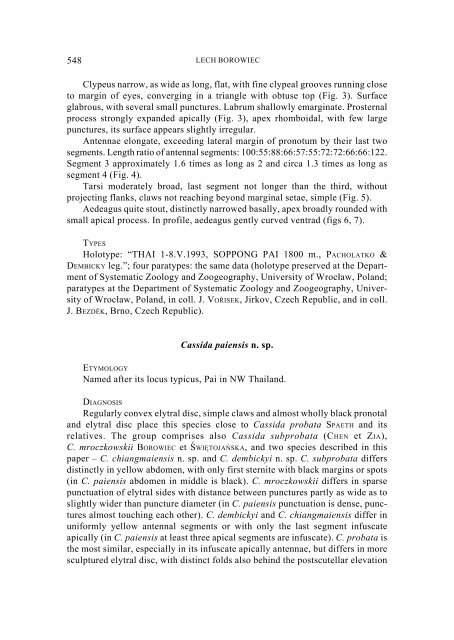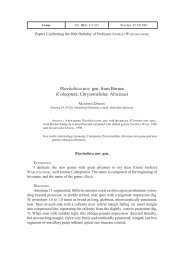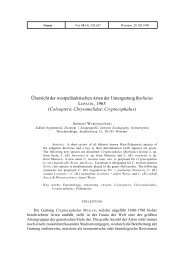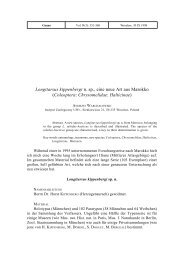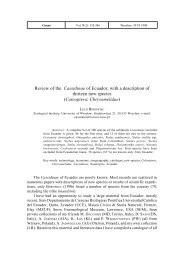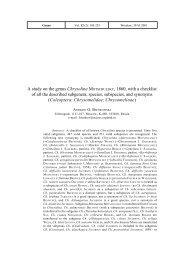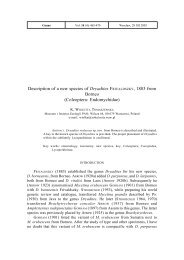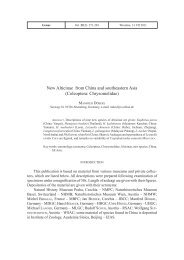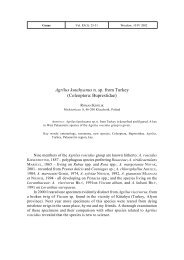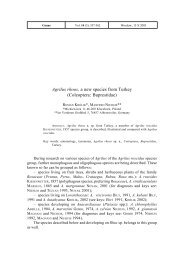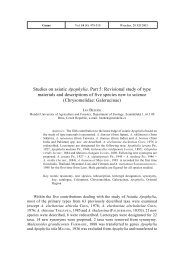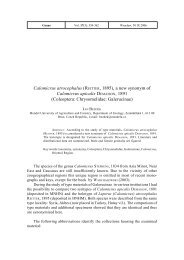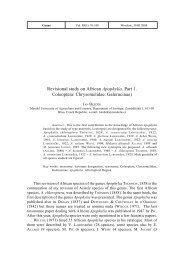New records of Asian and Australopapuan Cassidinae, with a ...
New records of Asian and Australopapuan Cassidinae, with a ...
New records of Asian and Australopapuan Cassidinae, with a ...
Create successful ePaper yourself
Turn your PDF publications into a flip-book with our unique Google optimized e-Paper software.
548<br />
LECH BOROWIEC<br />
Clypeus narrow, as wide as long, flat, <strong>with</strong> fine clypeal grooves running close<br />
to margin <strong>of</strong> eyes, converging in a triangle <strong>with</strong> obtuse top (Fig. 3). Surface<br />
glabrous, <strong>with</strong> several small punctures. Labrum shallowly emarginate. Prosternal<br />
process strongly exp<strong>and</strong>ed apically (Fig. 3), apex rhomboidal, <strong>with</strong> few large<br />
punctures, its surface appears slightly irregular.<br />
Antennae elongate, exceeding lateral margin <strong>of</strong> pronotum by their last two<br />
segments. Length ratio <strong>of</strong> antennal segments: 100:55:88:66:57:55:72:72:66:66:122.<br />
Segment 3 approximately 1.6 times as long as 2 <strong>and</strong> circa 1.3 times as long as<br />
segment 4 (Fig. 4).<br />
Tarsi moderately broad, last segment not longer than the third, <strong>with</strong>out<br />
projecting flanks, claws not reaching beyond marginal setae, simple (Fig. 5).<br />
Aedeagus quite stout, distinctly narrowed basally, apex broadly rounded <strong>with</strong><br />
small apical process. In pr<strong>of</strong>ile, aedeagus gently curved ventrad (figs 6, 7).<br />
TYPES<br />
Holotype: “THAI 1-8.V.1993, SOPPONG PAI 1800 m., PACHOLATKO &<br />
DEMBICKY leg.”; four paratypes: the same data (holotype preserved at the Department<br />
<strong>of</strong> Systematic Zoology <strong>and</strong> Zoogeography, University <strong>of</strong> Wroc³aw, Pol<strong>and</strong>;<br />
paratypes at the Department <strong>of</strong> Systematic Zoology <strong>and</strong> Zoogeography, University<br />
<strong>of</strong> Wroc³aw, Pol<strong>and</strong>, in coll. J. VOØISEK, Jirkov, Czech Republic, <strong>and</strong> in coll.<br />
J. BEZDÌK, Brno, Czech Republic).<br />
Cassida paiensis n. sp.<br />
ETYMOLOGY<br />
Named after its locus typicus, Pai in NW Thail<strong>and</strong>.<br />
DIAGNOSIS<br />
Regularly convex elytral disc, simple claws <strong>and</strong> almost wholly black pronotal<br />
<strong>and</strong> elytral disc place this species close to Cassida probata SPAETH <strong>and</strong> its<br />
relatives. The group comprises also Cassida subprobata (CHEN et ZIA),<br />
C. mroczkowskii BOROWIEC et ŒWIÊTOJAÑSKA, <strong>and</strong> two species described in this<br />
paper – C. chiangmaiensis n. sp. <strong>and</strong> C. dembickyi n. sp. C. subprobata differs<br />
distinctly in yellow abdomen, <strong>with</strong> only first sternite <strong>with</strong> black margins or spots<br />
(in C. paiensis abdomen in middle is black). C. mroczkowskii differs in sparse<br />
punctuation <strong>of</strong> elytral sides <strong>with</strong> distance between punctures partly as wide as to<br />
slightly wider than puncture diameter (in C. paiensis punctuation is dense, punctures<br />
almost touching each other). C. dembickyi <strong>and</strong> C. chiangmaiensis differ in<br />
uniformly yellow antennal segments or <strong>with</strong> only the last segment infuscate<br />
apically (in C. paiensis at least three apical segments are infuscate). C. probata is<br />
the most similar, especially in its infuscate apically antennae, but differs in more<br />
sculptured elytral disc, <strong>with</strong> distinct folds also behind the postscutellar elevation


